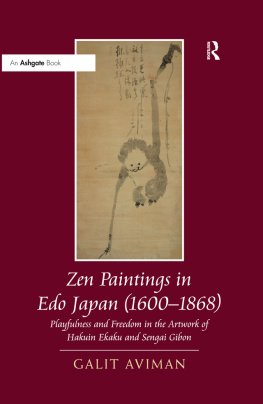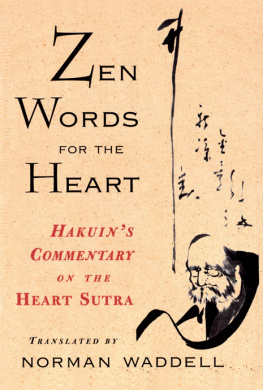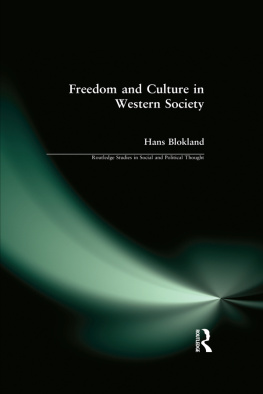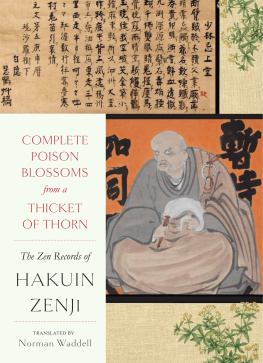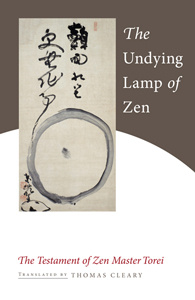ZEN PAINTINGS IN EDO JAPAN (16001868)
In Zen Buddhism, the concept of freedom is of profound importance. And yet, until now there has been no in-depth study of the manifestation of this liberated attitude in the lives and artwork of Edo period Zen monk-painters. This book explores the playfulness and free-spirited attitude reflected in the artwork of two prominent Japanese Zen monk-painters: Hakuin Ekaku (16851768) and Sengai Gibon (17501837). The free attitude emanating from their paintings is one of the qualities which distinguish Edo period Zen paintings from those of earlier periods. These paintings are part of a Zen ink painting tradition that began following the importation of Zen Buddhism from China at the beginning of the Kamakura period (11851333).
In this study, Aviman elaborates on the nature of this particular artistic expression and identifies its sources, focusing on the lives of the monk-painters and their artwork. The author applies a multifaceted approach, combining a holistic analysis of the paintings, i.e. as interrelated combination of text and image-with a contextualization of the works within the specific historical, art historical, cultural, social and political environments in which they were created.
Galit Aviman received her PhD at Ben-Gurion University of the Negev, Israel in cooperation with Kyoto University, Japan. She conducted her postdoctoral studies at the Edwin O. Reischauer Institute of Japanese Studies, Harvard University, USA. She lived in Japan for ten years in total. Currently she is a lecturer at Ben-Gurion University of the Negev, The Hebrew University and Tel-Aviv University.
Zen Paintings in Edo Japan (16001868)
Playfulness and Freedom in the Artwork of Hakuin Ekaku and Sengai Gibon
Galit Aviman
First published 2014 by Ashgate Publishing
Published 2016 by Routledge
2 Park Square, Milton Park, Abingdon, Oxon OX14 4RN
711 Third Avenue, New York, NY 10017, USA
Routledge is an imprint of the Taylor & Francis Group, an informa business
Copyright 2014 Galit Aviman
Galit Aviman has asserted her right under the Copyright, Designs and Patents Act, 1988, to be identified as the author of this work.
All rights reserved. No part of this book may be reprinted or reproduced or utilised in any form or by any electronic, mechanical, or other means, now known or hereafter invented, including photocopying and recording, or in any information storage or retrieval system, without permission in writing from the publishers.
Notice:
Product or corporate names may be trademarks or registered trademarks, and are used only for identification and explanation without intent to infringe.
British Library Cataloguing in Publication Data
A catalogue record for this book is available from the British Library
The Library of Congress has cataloged the printed edition as follows:
Aviman, Galit, 1970
Zen paintings in Edo Japan (16001868): playfulness and freedom in the artwork of Hakuin Ekaku and Sengai Gibon/by Galit Aviman.
pages cm
Includes bibliographical references and index.
ISBN 978-1-4094-7042-7 (hardcover: alk. paper) 1. Hakuin, 16861769Criticism
and interpretation. 2. Sengai, 17511837Criticism and interpretation. 3. Ink
painting, JapaneseEdo period, 16001868. 4. Calligraphy, JapaneseHistory
Edo period, 16001868. 5. Zen paintingJapan. 6. Zen calligraphyJapan. I.
Title.
ND2073.H35A95 2014
759.952dc23
2014019219
ISBN 9781409470427 (hbk)
Contents
Guide
- COLOR PLATES
- BLACK AND WHITE FIGURES
- 2 An Independent Artistic Language
- 3 Liberation from Rules
- 4 Letting Go of Common Conceptions
- 5 Emancipation from Social Conventions
- 6 Humor as an Expression of Freedom
This is a wonderful opportunity for me to express my gratitude to all those people who helped me with making this book possible.
I would like to thank Yad Hanadiv-Rothschild Fellowships 20102011 for funding my postdoctoral studies at the Edwin O. Reischauer Institute of Japanese Studies at Harvard University, where I dedicated most of my time to work on the book. A special thanks to Yukio Lippit, my host professor at Harvard, for his professional advice and for inviting me into such a wonderful environment for study and research. I would also like to thank Theodore J. Gilman, Executive Director of the Edwin O. Reischauer Institute and the Assistant Director, Stacie Matsumoto, for providing me and my family the opportunity to stay at the Edwin O. Reischauer house, where I could quietly work on my book in Reischauer's own office, complete with beautiful view and relaxed atmosphere.
I would like to extend my gratitude also to the Japan Foundation Fellowship Program for supporting my research in 2012 at the International Research Institute for Zen Buddhism at Hanazono Univeristy (IRIZ). I owe a special thanks to Yoshizawa Katsuhiro, who invited me to take part in his seminars and use the library facilities at Hanazono. I would also like to thank Yoshizawa and his assistant, Tomimasu Kentaro, for their great assistance in obtaining permission to use some of Hakuin's images.
My deepest gratitude goes to my advisor, Izumi Takeo, who served as my supervisor during my MA studies at Kyoto University in Japan, continued to guide me as a second supervisor during my PhD, and was always ready and willing to provide help and support. I owe deep gratitude also to Katrin Kogman-Appel, who was my primary PhD advisor and who guided me through my studies at the Ben-Gurion University of the Negev.
I would like to express a special thanks to my friend James Mark Shields, for professionally editing my book, for his helpful advice, and most of all for his friendship.
And to all my friends and colleagues who were there for the advice and support at different stages of my research: Jean-Sebastien Cluzel, Mori Toshiko, Aono Tomusuke, Leigh Chipman, Sara Offenberg, Nirit Ben-Aryeh Debby, and Daniel Unger.
Finally, I would like to thank my extended family with special thanks in particular to my beloved children and husband, for being who they are.
This book explores the free attitude and the playfulness reflected in the artwork of the two prominent Japanese Zen monk-painters from the Edo period (16001868)Hakuin Ekaku (16851768) and Sengai Gibon (17501837). The particular evolution of Zen paintings during the Edo period, including the artwork of Hakuin and Sengai, is usually referred to as Zenga ; lit. Zen paintings). These paintings are in fact part of a long tradition of Zen ink painting that began following the importation of Zen Buddhism from China at the beginning of the Kamakura period (11851333). Zenga is usually referred to as the revival of the early Zen painting of the Kamakura and early Muromachi periods (13331573), though in some aspects Zenga differs from those paintings, particularly from those of the fifteenth and sixteenth centuries.
The free attitude reflected in the paintings is one of the qualities that distinguish Zenga from Zen paintings of earlier periods. This book strives to understand the nature of this particular expression and to identify its sources, focusing on the lives of the monk-painters and their artwork. The emphasis is on the powerful interaction and the close collaboration that exists between words and images in the paintings.

